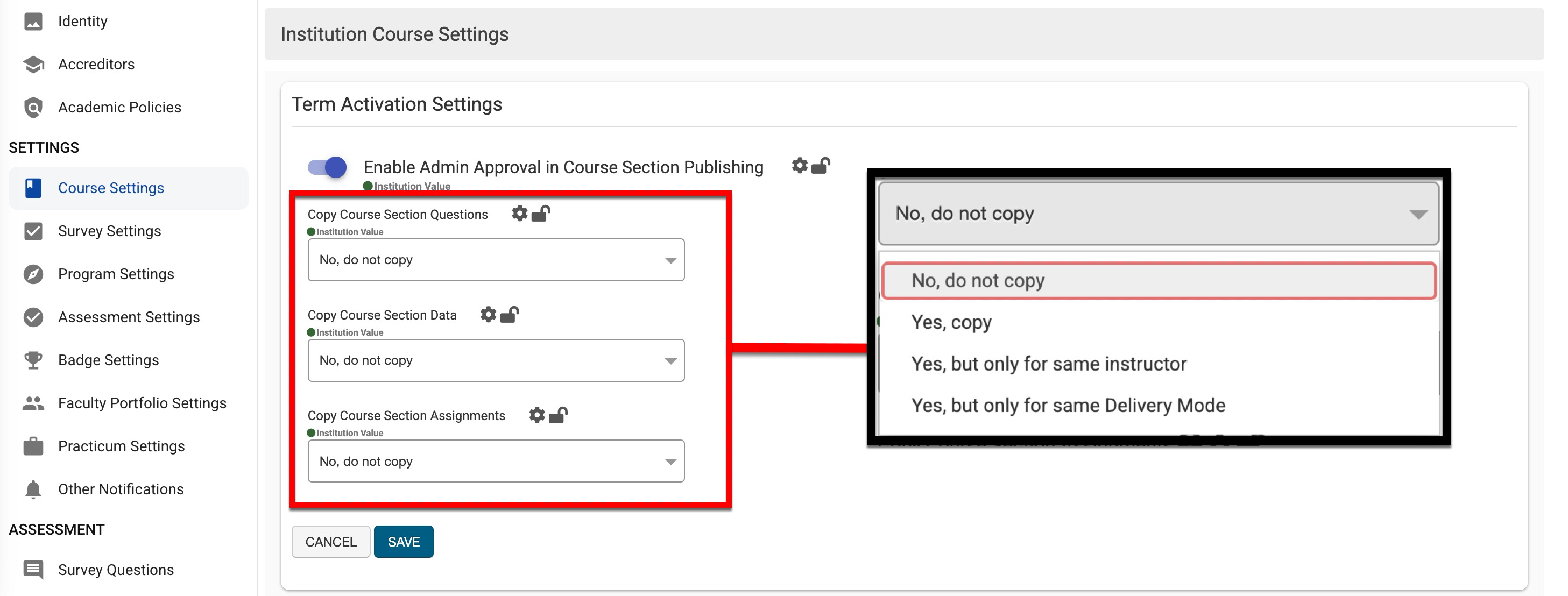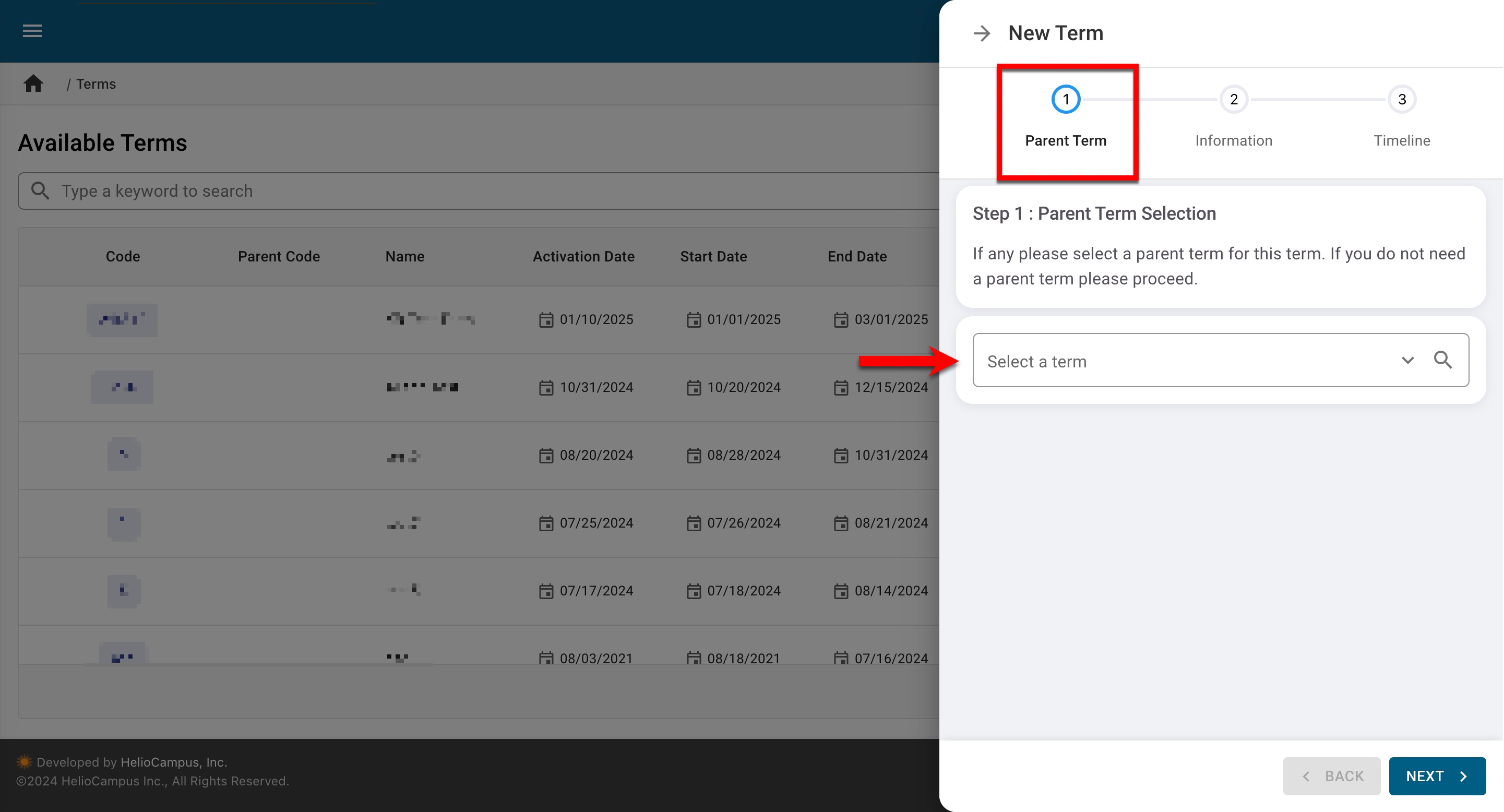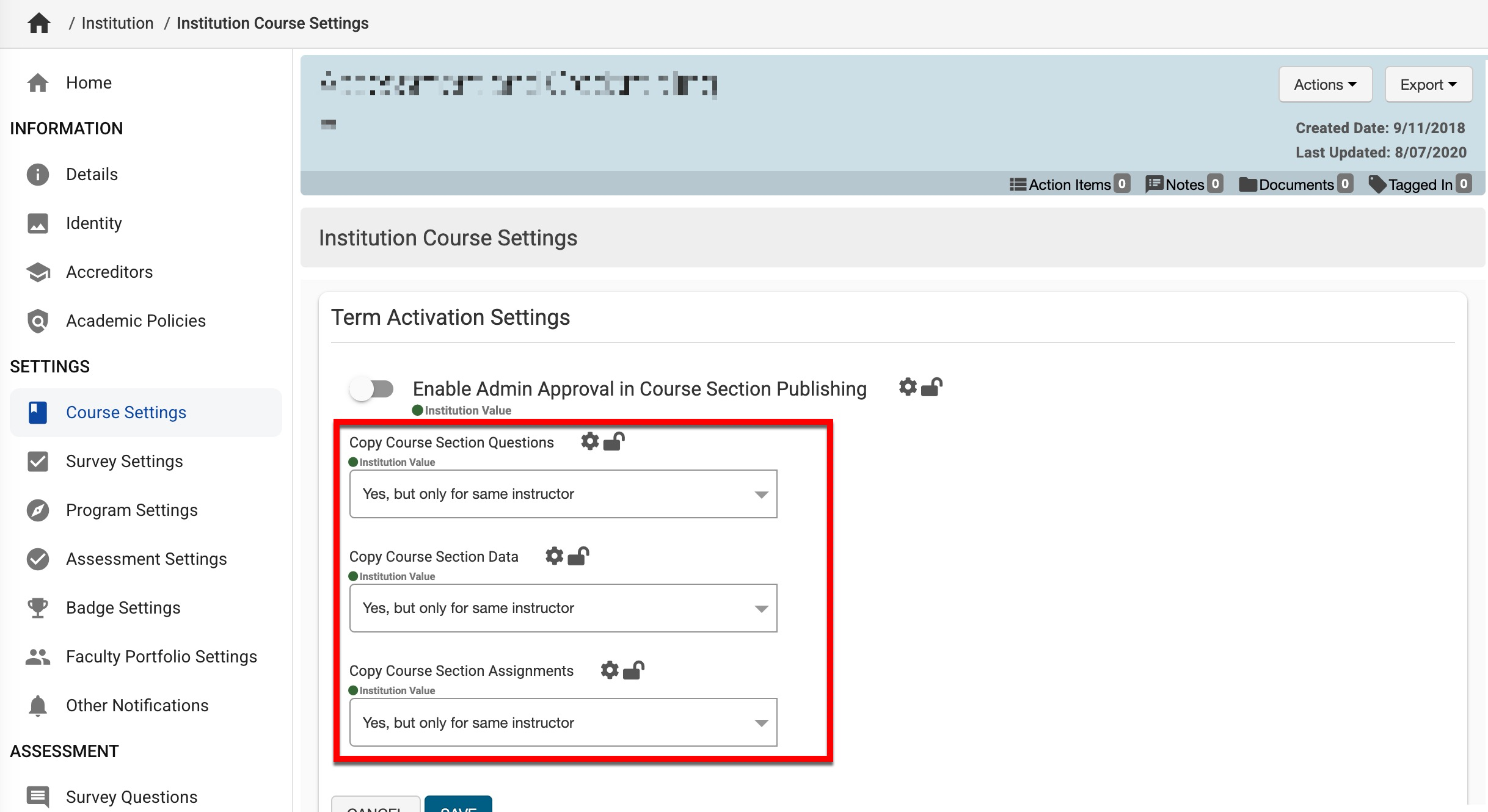Terms are required to ensure the accurate import of the data files sent to HelioCampus. They are created manually through the platform’s interface, via the platform’s import/export process, and with the Term data file STFP process. Terms define specific milestone dates on which various platform solutions are based. Institution Admin is the only role permitted to manage terms and term types. Terms are managed via the Term Manager and the Term Types Manager.
-
Main Menu > Admin Tools > Terms. Learn more about the Term Manager.

-
Main Menu > Admin Tools > Term Types. Learn more about term types.

Additionally, settings related to term activation and associated course section copy functionality are available via Course Settings at all Organizational Hierarchy levels.

Term Dates
|
Date |
Details |
|---|---|
|
Activation Date |
Upon the activation date, course section data, such as syllabi, assignments, assignment linking, survey questions, etc., will be copied across terms as configured, and course sections will be displayed in the Course Section Manager. This date causes the term status to change from Pending to Active. Additionally, notification offsets used in surveys and practicums utilize the term activation date as a milestone event for notification configuration. Learn more about copying data from term to term by reviewing Course Settings > Term Activation Settings at all levels of the Organizational Hierarchy, or learn about notification and offset configuration. |
|
Upon the term start date, the My Course Sections & Syllabi dashboard widget will populate, and Instructors or Admins can begin performing assignment linking. The start date causes the term status to change from Active to In Progress. When the end date is reached, the term's status will update to Completed, and various platform solutions, such as editing syllabi or enabling assessments, cannot be performed. Additionally, notification offsets used in surveys and practicums utilize the term start date as a milestone event for notification configuration. |
|
Notification offsets used in surveys, data collections, assignments, and practicums utilize the first and last day of class as milestone events for notification configuration. Learn more about notification and offset configuration. |
Term Types
A term type is an attribute used to categorize terms and determine the copying of course section content from term to term. Term types are especially important when rollover data is needed and are utilized for the below schedule-based functionality within the platform:
-
Surveys
-
Practicums
-
Data Collections
-
Assessments
Term types are created within the platform; only Institution Admins can create and manage them by navigating to Main Menu > Admin Tools > Term Types. Learn more about term types.
Parent & Partial Terms
![]()
Partial Terms are sub-terms that exist within a Parent Term and are associated with courses that are conducted for a shorter amount of time than they are in the Parent Term. For example, a course offered during a 12-week semester (Parent term) could be offered as an accelerated course during a 6-week semester (Partial Term). If Partial Terms exist within a Parent Term, then all course sections associated with the Parent Term must be associated with the Partial Terms; this ensures that data can be gathered via course assessments and surveys. Partial Terms can be created manually through the platform’s interface or via the platform’s import/export process.

Partial Term surveys follow different timelines than their Parent Terms to ensure course evaluation notifications are sent at the correct time for the Partial Term schedule, preventing early or late email notifications. The platform sends these Partial Term emails separately for each Partial Term, while still honoring the timeline from the Parent Term.
-
Results Available: The platform sends separate Results Available email notifications for each Partial Term when its corresponding Results Available date is reached.
-
Instructor Start: The platform sends separate Instructor Starts email notifications for each Partial Term when its corresponding Instructor Start date is reached.
Best Practices
-
Institutions should configure their term activation dates to occur before associated LMS course shells are made available to faculty. This ensures that assignment links will be properly copied. Term activation occurring after LMS course shells have been configured by faculty could result in broken assignment links.
-
Before term activation occurs:
-
Institutions should ensure that if course sections will be copied to the new term, the data being copied is finalized in the prior/current term.
-
Institutions should ensure syllabus template(s) have been finalized/published; this is the template aligned to the appropriate organizational hierarchy level to build the structure and outline of the syllabus. The most up-to-date syllabus template will be applied to new courses/course sections that are imported.
-
If the syllabus template is changed after term activation, associated courses and course sections must be manually updated to reflect the changes. Post-activation changes do not auto-copy.
-
-
-
Institutions should publish course sections once imported into the platform upon term activation. This ensures that students can view the syllabus for each course section when registering for classes through the Student Information System (SIS).

-
If auto-publish functionality is enabled at any level of the organizational hierarchy, course sections will auto-publish based on the configured Syllabus Form Auto Publish Date offsets. Learn more about this functionality.
-
-
When creating term types, the term code and name should be indicative of each other for ease of identification throughout the platform. For example, if the name is ‘Half Semester', the code field could be configured as 'TermType-HLFSEM'. Learn more about term types.
Term FAQ
When does HelioCampus begin accepting course sections, faculty, and enrollments via the SFTP data files?
This data is accepted for terms immediately upon creation and while in Draft status. Although accepted, data will be hidden and only available to HelioCampus Administrators until the term is published, i.e., in Pending status.
How does the platform determine the previous course section when copying section data during term activation?
During term activation, the platform will determine the previous course section to copy from by performing the following validations, in order.
-
First, the platform will review all terms and identify terms with the same term type and with a start date before the activation date of the activating term.
-
Then, the course section with the highest course section ID, matching subject code, and course code will be selected as the target section to copy from.

-
If Term Activation Settings at the Organizational Hierarchy level are configured to copy for only the same instructor or delivery mode, the platform will compare the Course Section Directors and Instructors or delivery mode against the same list of course sections to determine the target section to copy from. Learn more about Term Activations Settings.

-
📔 Additional Resources
